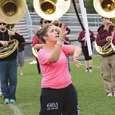.jpg)
Teaching marching and playing together is a daunting task. Building an excellent-sounding indoor ensemble takes hard work; transferring that sound outdoors, adding specialized instruments, and putting movement with it adds an entirely new set of difficulties.
Hamlet famously proclaimed, “The play’s the thing.” In marching, we can change that to “The setting’s the thing.” The tendency to practice music indoors and use the outdoors to concentrate on marching is understandable; a great deal of learning takes place during band camp, and indoor rehearsals provide a much-needed respite from the sun. However, no matter how well an ensemble may play indoors, things will inherently sound different outside with no band room roof and walls to enclose the group. Weather can wreak havoc with intonation, and when movement is added, what was a fine- sounding indoor ensemble is now something quite different. Indoor rehearsals are good for beginning to learn the music, but it is better to move outside sooner, rather than later.
In almost every other musical ensemble, we rehearse in a set-up similar to how the group will perform; the set-up the jazz ensemble or the concert band uses in rehearsal will be the same they use for performance. Many bands use an arc formation during outdoor music rehearsals, but in a typical marching show, the ensemble is typically spread out much farther than they are in the arcs. Thus, the music sounds differently. To account for this, we occasionally do warmups and musical rehearsals in formation sets from our marching drill. It helps students become familiar with how the ensemble will sound when not tightly packed together.
Out of a 90-minute daily rehearsal, we typically spend at least 20 minutes on musical warmups similar to what would be used in a concert band: long tones, lip slurs, pitch-matching and tuning exercises, scales, and chorales. The same fundamentals of tone production and intonation apply. At the University of Massachusetts I am fortunate to work with two outstanding marching teachers, Thom Hannum and Michael Klesch, both members of the Drum Corps International Hall of Fame. Both of these gentlemen have taught me much about the steps needed to produce a high-quality musical presentation on the marching field. One concept Michael stresses with students is thinking and playing in trios. Students are asked how their sound fits in with the people on either side of them. The trio concept carries over into the formations spread across the football field, just as it would when seated indoors.
The major difference in our outdoor warmups is the incorporation of foot movement. Regardless of what the musical exercise is, we ask our students to mark time. The benefits to this are numerous. It helps our students internalize the pulse and reinforces the need for their feet to be in time. In many cases it is out-of-time feet, rather than playing too heavily, that causes problems with tempo. While we might use a metronome, there are many times when warmups are done without an audible pulse. Students are responsible for getting the time from our drum majors’ conducting. The sound quality will initially be less than it was indoors, but through daily repetitions, students become more comfortable at moving their feet in time with playing.
Throughout the process, section leaders walk through the ranks, with eyes open for students whose marking time is not uniform. Such problems as incorrect raising of the heels, poor posture, and faulty horn carriage can all be addressed during the warmup. It is so effective marking time while warming up that we have had multiple indoor music rehearsals without chairs; students stand and mark time, just as they would on the field.
A common misconception is that marching bands play out of tune, but I have heard it said, “only bad marching bands play out of tune.” Tuning is an integral beginning to every rehearsal. The first sound at our rehearsals is a concert Bb, played by our first trumpeter. The ensemble then sings that pitch before playing it. Each wind player is tuned individually, thanks to tuner apps on smart phones as well as several small, hand-held tuners we distribute, this process only takes three minutes.
We then play tuning exercises. A favorite is to divide the ensemble into upper and lower voices. One group sustains a concert Bb, while the other group plays an ascending Bb scale against it; halfway up the scale, we typically reverse the roles, or play the remainder in unison. We also play chorales and songs such as our school alma mater, The Star Spangled Banner, or even our fight song played in a slow, legato style to work on tuning. This also helps build student familiarity with the music, killing two birds with one stone.
In a typical marching rehearsal, the director is stationed high above the ensemble. We rent a 26-foot-high scissor lift for the season, which we keep centered on the 50-yard line, roughly eight to ten feet from the sidelines. Although this is terrific for seeing the entire band in formation, it is not always the best vantage point for listening. The band is not judged by how it sounds to those directly in front but by how it sounds to an audience that is seated farther away. The sound I hear, high above but relatively close to the ensemble, is often different from how it will sound to spectators or adjudicators.
Compounding the difficulty is the extensive front ensemble we use. The balance between on-field instruments and those on the front sidelines is impossible to gauge from up above. It is not uncommon for me to be up high, while Thom Hannum assesses the sound from field level, standing 75-80 feet away. This may not be an option for everyone, but the more rehearsal time you can get in a stadium, the more accurately you will be able to assess your ensemble’s sound in a realistic performance setting.
Outdoor tone quality can be a frequent battle. What may have been an impressive fortissimo indoors can lack the same effect when played outdoors, spread across a football field. There is typically a tendency to overcompensate, which can lead to poor tone quality and even larger balance problems. Some may disagree, but I am okay with letting students test their limits. They need to first produce the sound, and then can be taught the line of acceptable tone. I would much prefer a student be able to produce a big sound and have to pull it back, than have him struggle to produce enough sound.
The entire range of dynamics often should be reassessed when moved outdoors. Softer moments, such as a solo passage in a ballad, can only be judged effectively based on how they sound from the audience. Anything on the soft side of the spectrum may need to be increased a level from how it was played indoors.
Entrances and releases for wind players can be problematic in any setting, but they are magnified when on the field. Articulation is important; we all know how mushy a concert band with poor articulations can sound. Much marching music requires a strong entrance to have the desired effect; as such, it is imperative that band members correctly interpret articulations.
Many directors arrange music for their students. When arranging, I am meticulous about notating articulations. I do not want to leave interpretations of the sound I have in mind to chance. If the music is marked well, the onus then falls on the band staff to make sure each student is playing the articulations as written. By the time marching is added to the equation, musical elements such as articulations and dynamics should be so automatic that students don’t have to think about them.
The difficulty in releases comes from the physical nature of what marching groups do. The breath support needed to support a long tone is now further strained by the physical exhaustion from marching; in a fast tempo, it is difficult to sustain a chord while on the move. This is another area where having an extra set of ears further back can make a huge difference. From right on top of the field, everything may sound normal, but from the audience’s perspective, the sound may be deteriorating long before it reaches the ear.
There is no silver bullet approach that addresses all difficulties with sustaining notes, but as with articulations, I have found that it pays to be meticulous. Long before the season begins, go through your scores and notate where each release is. If you have the opportunity to work with section leaders and instructional staff before band camp, share this information with them, have them notate the releases in their music, and, if possible, have them practice teaching the music to each other. When band camp begins, they can help teach the rest of the ensemble the music, with attention paid to articulation, sustain and release. Insistence on these nuances from every member of the teaching staff, from the director down to the section leaders, can help reinforce the importance of paying attention to these details.
One of the reasons we emphasize watching the drum majors during the warmups is that we want the ensemble to be dependent on them for tempo during a performance. As spread out as a band can be across the field, there can be delays in relying upon the battery for pulse. It has been my experience that if a student is listening back to the drumline for tempo, chances are he will be behind. The goal is for the band’s feet to be in time with the drum major’s hands. In almost every band setting, we ask students to listen, but on the marching field, students should get the pulse by watching the drum major. This requires drum majors to be prepared at every rehearsal and have their tempos internalized. It is a good idea to require each drum major to have a metronome with them for every rehearsal and performance.
Last fall, we performed Michael Klesch’s arrangement of Stravinsky’s Firebird. There was one drill move that just didn’t seem to work. Michael concentrated on that section, changing the instrumentation with each run-through. The first time, the tubas played while everyone else sang. If that was corrected, he would add other low brass instruments or a different line, such as the alto saxophones and mellophones. Meanwhile the trumpets, clarinets, and flutes continued to sing. Later, he reversed the groupings and had only the upper instruments play. Regardless of who was playing, each time, everyone marched the drill. When we put the full ensemble back together, everything was improved. Band members hit their drill spots in time, and the music was much cleaner. In an indoor ensemble, it is common practice to isolate sections that might need attention. That is what Michael did; the only difference was, he addressed the musical problems in the context of the marching. It was the same teaching principle often used indoors, only adapted for the added feature of movement.
The first time a marching group plays outside, there will be noticeable differences. Add the variables of moving while playing, an open-aired environment, band members spread out on a field, an audience seated far away, and unpredictable weather, and no ensemble will sound like it did inside. Nevertheless, the principles of performance remain the same.






